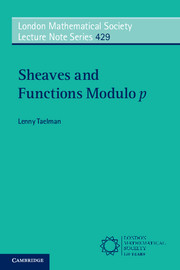Book contents
- Frontmatter
- Contents
- Introduction
- Chapter 1 τ-sheaves, crystals, and their trace functions
- Chapter 2 Functors between categories of crystals
- Chapter 3 The Woods Hole trace formula
- Chapter 4 Elementary applications
- Chapter 5 Crystals with coefficients
- Chapter 6 Cohomology of symmetric powers of curves
- Chapter 7 Trace formula for L-functions
- Chapter 8 Special values of L-functions
- Appendix A The trace formula for a transversal endomorphism
- Bibliography
- Index
Chapter 3 - The Woods Hole trace formula
Published online by Cambridge University Press: 05 November 2015
- Frontmatter
- Contents
- Introduction
- Chapter 1 τ-sheaves, crystals, and their trace functions
- Chapter 2 Functors between categories of crystals
- Chapter 3 The Woods Hole trace formula
- Chapter 4 Elementary applications
- Chapter 5 Crystals with coefficients
- Chapter 6 Cohomology of symmetric powers of curves
- Chapter 7 Trace formula for L-functions
- Chapter 8 Special values of L-functions
- Appendix A The trace formula for a transversal endomorphism
- Bibliography
- Index
Summary
The Woods Hole trace formula
The Grothendieck group of crystals
Let X be a noetherian scheme over Fq. Denote by K0(X) the Grothendieck group of the abelian category CrysX. This is the abelian group generated by isomorphism classes [ℱ] of crystals, modulo relations [ℱ2] = [ℱ1] + [ℱ3] for every short exact sequence 0→ℱ1→ℱ2→ ℱ3→ 0 in CrysX.
Proof. For every i the exact sequence 0 → ℱi+1 → ℱi → ℱi/ℱi+1 → 0 gives [ℱi] − [ℱi+1] = [ℱi/ℱi+1] in K0(X) which summing over all i ∈ {0, …, n − 1} gives the claimed identity.
Lemma 3.2. Let ℱ• be a bounded complex of crystals on X. Then
in K0(X).
It follows that if 0 →ℱ1→ … → ℱn → 0 is exact in CrysX then
Proof of Lemma 3.2. On the one hand, the complex ℱ• splits into short exact sequences
while on the other hand the cohomology crystals sit in short exact sequences
Taking the alternating sum over i of the resulting identities in K0(X) and comparing the terms yields the desired identity
Since the functor − ⊗ − on crystals is exact in both arguments (Corollary 2.8), it induces a bi-additive map
which gives K0(X) the structure of a commutative ring.
Similarly, for a map ℱ : X → Y of noetherian schemes over Fq the functor ℱ : CrysY →CrysX is exact (Corollary 2.2), so it induces a map
This map is a ring homomorphism.
Finally, if ℱ : X → Y is a separated map of finite type between noetherian schemes over Fq then the long exact sequence of Theorem 2.33 combined with Lemma 3.2 shows that the map
is well-defined. It is additive, but in general not a ring homomorphism. It has the following important transitivity property.
Proposition 3.3. Let ℱ : X → Y and g : Y → Z be separated morphisms of finite type between noetherian schemes overFq. Then R(gℱ)! = Rg! ◦ Rℱ! as maps from K0(X) to K0(Z).
- Type
- Chapter
- Information
- Sheaves and Functions Modulo pLectures on the Woods Hole Trace Formula, pp. 43 - 56Publisher: Cambridge University PressPrint publication year: 2015



